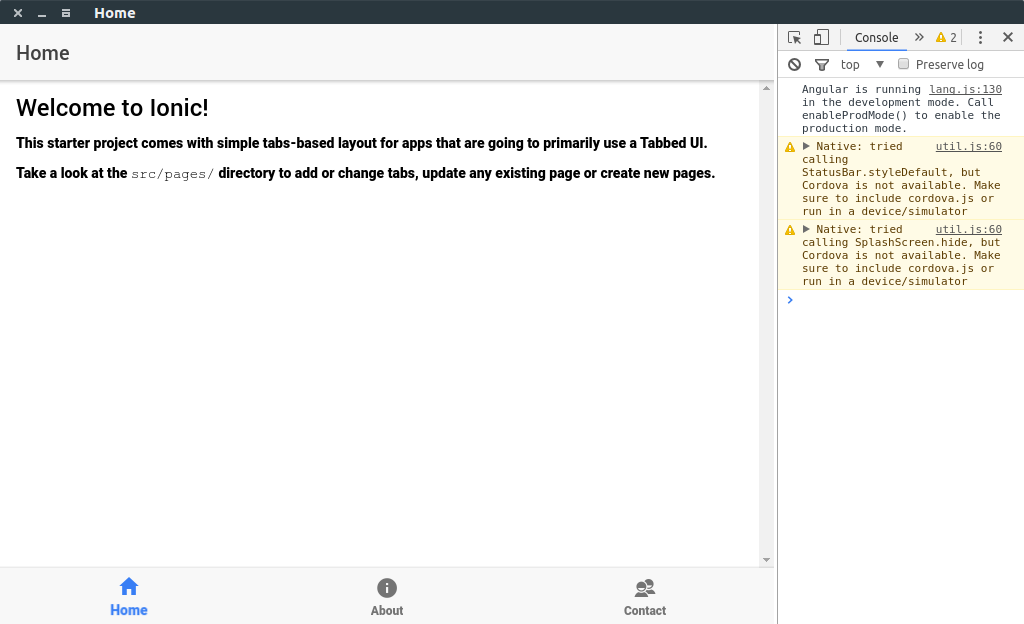Ionic3 与Electron制作桌面应用
ionic:https://ionicframework.com
electron:https://electron.atom.io
ionic是一个混合开发框架,electron是一个开发跨平台桌面应用的框架。
此教程包括三个步骤:
1. 创建ionic项目,开启服务
2. 在项目中添加electron依赖
3. 添加webpack配置和electron主体脚本以electron的方式运行项目
在教程第二部分,首先会创建一个简单的angular2服务来访问electron的api;然后给不同平台编译分包。
最终源代码地址:https://github.com/lohanitech/ion-electron
准备工作和预备知识:
1 安装和了解ionic
2 安装和了解electron
1. 创建Ionic项目,开启服务
运行如下命令
ionic start ion-electron
进入ion-electron文件夹运行:
ionic serve
可以在本地浏览器中输入 http://localhost:8100 预览效果
2. 在项目中安装electron依赖
在项目中运行如下命令:
npm install electron electron-builder foreman --save-dev
electron是我们要整合进来的一个桌面开发
electron-builder用于编译electron的脚本
foreman用于模拟多进程的node包。
安装完成后,package.json如下:
"name": "ion-electron", "author": { "name": "Damodar Lohani", "email": "example@example.com", "url": "https://lohanitech.com/members/damodar-lohani" }, "description": "ionic framework based electron project", "main": "electron/electron.js", "config": { "ionic_bundler": "webpack", "ionic_webpack": "./config/webpack.config.js" }, "build": { "appId": "com.lohanitech.ionic-electron-test", "electronVersion": "1.7.5", "asar":false, "files": [ "www/**/*", "electron/*" ] }
3. 添加webpack配置和electron主体脚本以electron的方式运行项目
在项目中新建一个文件夹名为config,并在其中加入一个文件名为webpack.config.js,将如下代码复制进去。
首先是ionic相关的配置,(目前位于 node_modules/@ionic/app-scripts/config/webpack.config.js),在源文件中加入:
externals: [ (function () { var IGNORES = ["fs","child_process","electron","path","assert","cluster","crypto","dns","domain","events","http","https","net","os","process","punycode","querystring","readline","repl","stream","string_decoder","tls","tty","dgram","url","util","v8","vm","zlib"]; return function (context, request, callback) { if (IGNORES.indexOf(request) >= 0) { return callback(null, "require('" + request + "')"); } return callback(); }; })() ],
最新的webpack配置变为如下(最新的配置文件我们需要在dev配置和production配置中添加):
/* * The webpack config exports an object that has a valid webpack configuration * For each environment name. By default, there are two Ionic environments: * "dev" and "prod". As such, the webpack.config.js exports a dictionary object * with "keys" for "dev" and "prod", where the value is a valid webpack configuration * For details on configuring webpack, see their documentation here * https://webpack.js.org/configuration/ */ var path = require('path'); var webpack = require('webpack'); var ionicWebpackFactory = require(process.env.IONIC_WEBPACK_FACTORY); var ModuleConcatPlugin = require('webpack/lib/optimize/ModuleConcatenationPlugin'); var PurifyPlugin = require('@angular-devkit/build-optimizer').PurifyPlugin; var optimizedProdLoaders = [ { test: /.json$/, loader: 'json-loader' }, { test: /.js$/, loader: [ { loader: process.env.IONIC_CACHE_LOADER }, { loader: '@angular-devkit/build-optimizer/webpack-loader', options: { sourceMap: true } }, ] }, { test: /.ts$/, loader: [ { loader: process.env.IONIC_CACHE_LOADER }, { loader: '@angular-devkit/build-optimizer/webpack-loader', options: { sourceMap: true } }, { loader: process.env.IONIC_WEBPACK_LOADER } ] } ]; function getProdLoaders() { if (process.env.IONIC_OPTIMIZE_JS === 'true') { return optimizedProdLoaders; } return devConfig.module.loaders; } var devConfig = { entry: process.env.IONIC_APP_ENTRY_POINT, output: { path: '{{BUILD}}', publicPath: 'build/', filename: '[name].js', devtoolModuleFilenameTemplate: ionicWebpackFactory.getSourceMapperFunction(), }, externals: [ (function () { var IGNORES = ["fs","child_process","electron","path","assert","cluster","crypto","dns","domain","events","http","https","net","os","process","punycode","querystring","readline","repl","stream","string_decoder","tls","tty","dgram","url","util","v8","vm","zlib"]; return function (context, request, callback) { if (IGNORES.indexOf(request) >= 0) { return callback(null, "require('" + request + "')"); } return callback(); }; })() ], devtool: process.env.IONIC_SOURCE_MAP_TYPE, resolve: { extensions: ['.ts', '.js', '.json'], modules: [path.resolve('node_modules')] }, module: { loaders: [ { test: /.json$/, loader: 'json-loader' }, { test: /.ts$/, loader: process.env.IONIC_WEBPACK_LOADER } ] }, plugins: [ ionicWebpackFactory.getIonicEnvironmentPlugin(), ionicWebpackFactory.getCommonChunksPlugin() ], // Some libraries import Node modules but don't use them in the browser. // Tell Webpack to provide empty mocks for them so importing them works. node: { fs: 'empty', net: 'empty', tls: 'empty' } }; var prodConfig = { entry: process.env.IONIC_APP_ENTRY_POINT, output: { path: '{{BUILD}}', publicPath: 'build/', filename: '[name].js', devtoolModuleFilenameTemplate: ionicWebpackFactory.getSourceMapperFunction(), }, externals: [ (function () { var IGNORES = ["fs","child_process","electron","path","assert","cluster","crypto","dns","domain","events","http","https","net","os","process","punycode","querystring","readline","repl","stream","string_decoder","tls","tty","dgram","url","util","v8","vm","zlib"]; return function (context, request, callback) { if (IGNORES.indexOf(request) >= 0) { return callback(null, "require('" + request + "')"); } return callback(); }; })() ], devtool: process.env.IONIC_SOURCE_MAP_TYPE, resolve: { extensions: ['.ts', '.js', '.json'], modules: [path.resolve('node_modules')] }, module: { loaders: getProdLoaders() }, plugins: [ ionicWebpackFactory.getIonicEnvironmentPlugin(), ionicWebpackFactory.getCommonChunksPlugin(), new ModuleConcatPlugin(), new PurifyPlugin() ], // Some libraries import Node modules but don't use them in the browser. // Tell Webpack to provide empty mocks for them so importing them works. node: { fs: 'empty', net: 'empty', tls: 'empty' } }; module.exports = { dev: devConfig, prod: prodConfig }
这是ionic的webpack配置,只需稍作改动就可以与electron一起使用了。
添加election主脚本
在项目内创建一个文件夹名为electron,在其中新建一个electron.js。这个是创建和加载electron窗口的主脚本。打开electron.js,贴入以下代码:
'use strict'; const electron = require('electron'); // Module to control application life. const { app } = electron; // Module to create native browser window. const { BrowserWindow } = electron; let win; function createWindow() { // Create the browser window. win = new BrowserWindow({ 1024, height: 600 }); var url = 'file://' + __dirname + '/../www/index.html'; var Args = process.argv.slice(2); Args.forEach(function (val) { if (val === "test") { url = 'http://localhost:8100' } }); // and load the index.html of the app. win.loadURL(url); // Open the DevTools. win.webContents.openDevTools(); // Emitted when the window is closed. win.on('closed', () => { // Dereference the window object, usually you would store windows // in an array if your app supports multi windows, this is the time // when you should delete the corresponding element. win = null; }); } // This method will be called when Electron has finished // initialization and is ready to create browser windows. // Some APIs can only be used after this event occurs. app.on('ready', createWindow); // Quit when all windows are closed. app.on('window-all-closed', () => { // On OS X it is common for applications and their menu bar // to stay active until the user quits explicitly with Cmd + Q if (process.platform !== 'darwin') { app.quit(); } }); app.on('activate', () => { // On OS X it's common to re-create a window in the app when the // dock icon is clicked and there are no other windows open. if (win === null) { createWindow(); } });
在package.json中加入启动脚本
在package.json的scripts中贴入以下代码:
"scripts": { "dev": "nf start", "start":"ionic-app-scripts serve", "electron dist": "electron .", "ebuild":"npm run build && node_modules/.bin/build", "clean": "ionic-app-scripts clean", "build": "ionic-app-scripts build", "ionic:build": "ionic-app-scripts build", "ionic:serve": "ionic-app-scripts serve" }
由于现在加入了foreman,我们需要给他添加配置。在项目根目录下新建文件Procfile,贴入代码:
ionic: npm start
electron: node electron-wait-ionic.js
在根目录下新建electron-wait-ionic.js,更新如下:
const net = require('net');
const port = 8100;
process.env.E_URL = `http://localhost:${port}`;
const client = new net.Socket();
let startedElectron = false;
const tryConnection = () => client.connect({port: port}, () => {
client.end();
if(!startedElectron) {
console.log('starting electron');
startedElectron = true;
const exec = require('child_process').exec;
exec('electron .');
}
}
);
tryConnection();
client.on('error', (error) => {
setTimeout(tryConnection, 1000);
});
这个脚本的作用是尝试连接端口8100,因为8100端口在electron接入的时候会激活。如果连接失败会接着连接。
此时,运行npm run dev会以开发模式运行项目。
由于electron在完全编译之前会运行服务,所以第一次可能会看到空白页面,发生这种情况的话可以根据console输出信息,在编译完成后按ctrl+r重新加载electron窗口即可。
正常工作的效果图如下:

完成此教程可以查看第二部分来学习如何在Ionic项目中访问electron的api。